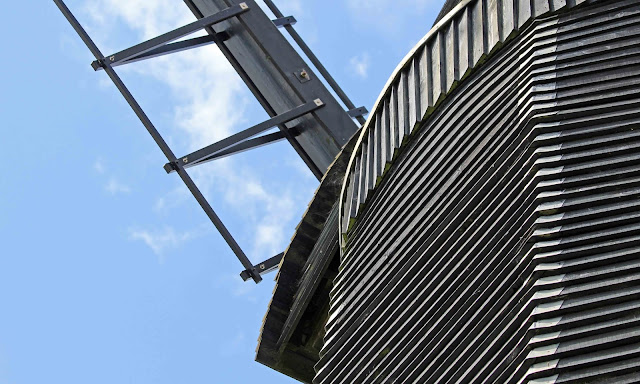On
Wednesday 15 August my friend Jill and I set off on a walk to Rottingdean Windmill
– its silhouette can just be seen on the hill in the top left of my photo.
We could actually have parked much closer but where’s the fun in that? Instead,
we parked near Brighton Marina and walked along the undercliff path to the
charming little town of Rottingdean.
After
recharging our batteries with tea and cake, we enjoyed a stroll around the town
(taking a turn in Rudyard Kipling’s walled garden, marvelling at the
Burne-Jones stained glass windows in St Margaret’s Church). From the village
green, we could see the windmill on the horizon – time to climb that hill!
We
huffed and puffed up a very steep Rottingdean street, turned a corner and there
across the meadow of the Beacon Hill Nature Reserve was the mill.
Built
on Beacon Hill in 1802, this smock mill ground corn into flour until sometime
in the 1880s but, as you can tell from the fact that its sweeps are now empty,
it no longer functions. The sweeps are turned from time to time though, as part
of the regular maintenance of the building. The old photo of the mill is taken
from the signboard at the site - I like how the figure of the man in the doorway gives an idea of the mill's size.
Although
this sign on the side of the mill says that William Nicholson’s drawing of this
windmill became the colophon for the Heinemann publishing company, that may not
necessarily be true. The Rottingdean Preservation Society now looks after this
structure and on their website (which provides a detailed history of the mill),
it states that the Heinemann logo actually shows a post mill, whereas this is a
smock mill - the silhouette is different
A
couple of closer shots of the mill structure. The mill is made of wood that has
been covered with tar to protect it against the weather.
We
continued our walk along the trails that run through the nature reserve.
Looking back towards the mill, you can see how close to the sea it is, and how
exposed the site is to wild winds and stormy weather. It’s a testament to the Preservation Society
that ‘well over 100 years since it last ground corn for
the village, this mill still remains a landmark for all to see and enjoy.’








No comments:
Post a Comment